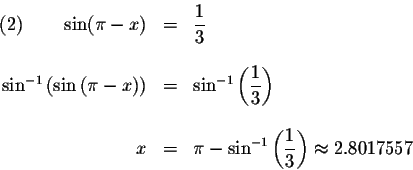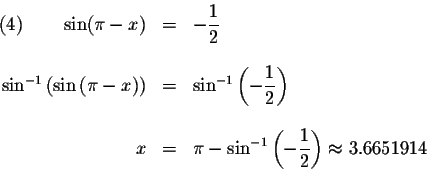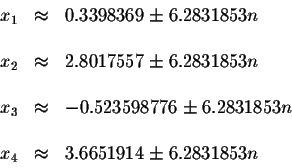 SOLVING TRIGONOMETRIC EQUATIONS
SOLVING TRIGONOMETRIC EQUATIONS SOLVING TRIGONOMETRIC EQUATIONS
SOLVING TRIGONOMETRIC EQUATIONS
Note: If you would like a review of trigonometry, click on trigonometry.
Problem 9.6a: Solve for x in the equation
Answer: The exact answers are

The approximate values of these solutions are

Solution:
There are an infinite number of solutions to this problem.
Isolate the sine term. To do this rewrite the left side of the equation in an equivalent factored form.

The only way the product of two factors equals zero is if at least one of
the factors equals zeros. This means that
![]() if
if
![]() or
or
![]()
We have transformed a difficult problem into two problems. To find the
solutions to the original equation,
![]() ,
we find the solutions to the equations
,
we find the solutions to the equations
![]() and
and
![]()


How do we isolate the x? We could take the arcsine of both sides. However, the sine function is not a one-to-one function.
We can restrict the domain of the function so that the function is
one-to-one on the restricted domain while preserving the original range. The graph of the sine function is one-to-one on the interval
![$\left[ -\displaystyle \displaystyle \frac{\pi }{2},\displaystyle \displaystyle \frac{\pi }{2}\right] .$](img11.gif) If we restrict the domain of the sine function to that interval , we can take the arcsine of both sides of each equation.
If we restrict the domain of the sine function to that interval , we can take the arcsine of both sides of each equation.

We know that
![]() Therefore,
if
Therefore,
if
 ,
then
,
then


We complete the problem by solving for the second factor.

We know that
![]() Therefore,
if
Therefore,
if
 ,
then
,
then


Since the period of ![]() equals
equals ![]() ,
these solutions will repeat
every
,
these solutions will repeat
every ![]() units. The exact solutions are
units. The exact solutions are

The approximate values of these solutions are

One can check each solution algebraically by substituting each solution in the original equation. If, after the substitution, the left side of the original equation equals the right side of the original equation, the solution is valid.
One can also check the solutions graphically by graphing the function formed by the left side of the original equation and graphing the function formed by the right side of the original equation. The x-coordinates of the points of intersection are the solutions. The right side of the equation is 0 and f(x)=0 is the x-axis. So really what you are looking for are the x-intercepts to the function formed by the left side of the equation.
Algebraic Check:
Check solution

Left Side:
Right Side: 0
Since the left side of the original equation equals the right side of the original equation when you substitute 0.3398369 for x, then 0.3398369 is a solution.
Check solution

Left Side:
Right Side: 0
Since the left side of the original equation equals the right side of the original equation when you substitute 2.8017557 for x, then 2.8017557 is a solution.
Check solution

Left Side:
Right Side: 0
Since the left side of the original equation equals the right side of the original equation when you substitute -0.523598776 for x, then <tex2htmlcommentmark> -0.523598776 is a solution.
Check solution

Left Side:
Right Side: 0
Since the left side of the original equation equals the right side of the original equation when you substitute 3.6651914 for x, then 3.6651914 is a solution.
We have just verified that the exact solutions
 and
and
 are the exact solutions and
these solutions repeat every
are the exact solutions and
these solutions repeat every ![]() units. The approximate values of
these solutions are
units. The approximate values of
these solutions are
![]() -0.523598776, and 3.6651914 and these solutions repeat every
-0.523598776, and 3.6651914 and these solutions repeat every
![]() units.
units.
Graphical Check:
Graph the equation
![]() Note that the graph crosses the x-axis many times indicating many
solutions.
Note that the graph crosses the x-axis many times indicating many
solutions.
The graph crosses the x-axis at 0.3398369. Since the period is
![]() ,
the graph also crosses the x-axis again at
<tex2htmlcommentmark>
0.3398369+6.2831853=6.6230222 and at
,
the graph also crosses the x-axis again at
<tex2htmlcommentmark>
0.3398369+6.2831853=6.6230222 and at
![]() ,
etc.
,
etc.
The graph crosses the x-axis at
![]() .
Since the period is
.
Since the period is
![]() ,
the graph also crosses the x-axis again at
<tex2htmlcommentmark>
2.8017557+6.2831853=9.084941007 and at
,
the graph also crosses the x-axis again at
<tex2htmlcommentmark>
2.8017557+6.2831853=9.084941007 and at
![]() ,
etc.
,
etc.
The graph crosses the x-axis at
![]() .
Since the period is
.
Since the period is
![]() ,
the graph also crosses the x-axis again at
<tex2htmlcommentmark>
-0.523598776+6.2831853=5.7595865 and at
,
the graph also crosses the x-axis again at
<tex2htmlcommentmark>
-0.523598776+6.2831853=5.7595865 and at
![]() ,
etc.
,
etc.
The graph crosses the x-axis at
![]() .
Since the period is
.
Since the period is
![]() ,
the graph also crosses the x-axis again at
<tex2htmlcommentmark>
3.6651914+6.2831853=9.9483767 and at
,
the graph also crosses the x-axis again at
<tex2htmlcommentmark>
3.6651914+6.2831853=9.9483767 and at
![]() ,
etc.
,
etc.
Note: If the problem were to find the solutions in the interval
![]() ,
then you choose those solutions from the set of infinite
solutions that belong to the set
,
then you choose those solutions from the set of infinite
solutions that belong to the set
![]()
![]() ,
5.7595865 and
3.6651914.
,
5.7595865 and
3.6651914.
If you would like to review problem 9.4b, click on problem 9.4b.
If you would like to go to the next section, click on next.
If you would like to go back to the previous section, click on previous.
If you would like to go back to the equation table of contents, click on Contents.

